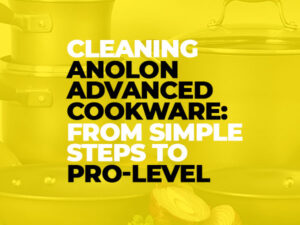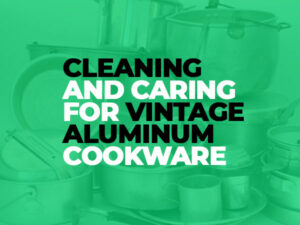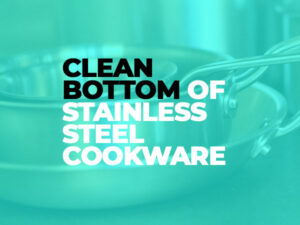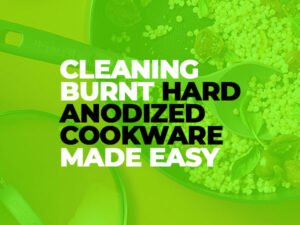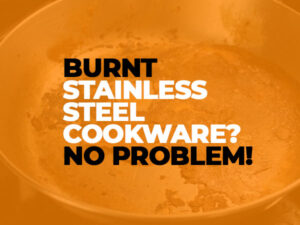Well-seasoned cast iron skillets are culinary workhorses due to their heat retention and non-stick properties. However, repeated usage can leave black residue on this gourmet classic, impairing its performance. Learning how to clear this black residue without ruining the skillet’s seasoning is crucial for its longevity and cooking effectiveness.
This complete instruction will cover how to remove black residue from your cast iron skillet. We can help you with rust, minimal soap, salt and oil scrub, or other methods. Preventive measures and skillet seasoning tips are also covered. You can restore your cast iron skillet to its former glory and enjoy delicious, evenly-cooked dishes for years with the appropriate maintenance.
What is the Black Cast Iron Skillet Residue Called?
The black residue on a cast iron pan is called “seasoning.” It’s polymerized oil that’s attached to the skillet’s surface. This procedure gives cast iron its non-stick and rust-proof qualities.
This seasoning is made by coating the skillet with a thin layer of vegetable oil like canola or flaxseed oil and heating it to a certain temperature. This heating procedure chemically transforms oil into a hard, slick surface that sticks to iron. This layer keeps food from adhering to the skillet and gives it a deep, dark color.
Cast iron cookware needs seasoning for many reasons. It improves the skillet’s non-stick qualities, making cooking and cleaning easier. Protecting the iron from moisture prevents rust and extends the skillet’s lifespan. Seasoning also adds a subtle depth of flavor to skillet-cooked dishes.
preserve this seasoning layer intact to preserve a cast iron skillet in good condition. Cleaning the skillet properly protects the seasoning. Despite appearances, simple washing with hot water and a brush or scraper, followed by a thin layer of oil and heating, helps create and maintain cast iron skillets’ cherished seasoning.
Cleaning Black Residue From Cast Iron Skillet: Step-by-Step Guide
Cleaning black residue from a cast iron pan is common to maintain seasoning and prevent food from sticking. Clean it effectively using this step-by-step guide:
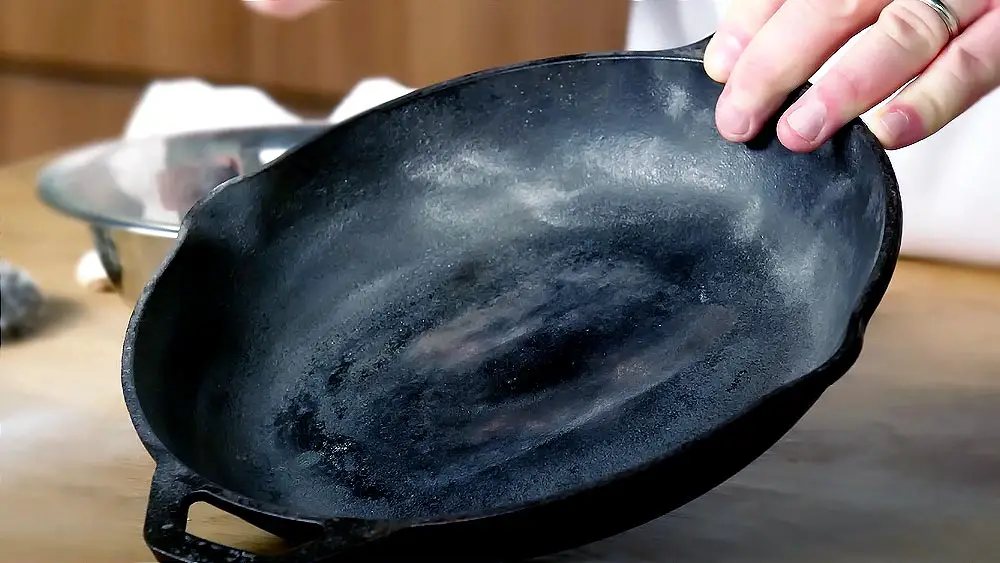
Materials needed:
- Hot water
- A soft sponge or scrubber
- Optional mild dish soap
- Clean cloth or paper towels
- Either vegetable oil or shortening
- Potholder or oven mitt
Step 1: Cool the Skillet
Before cleaning your cast iron skillet, emphasize safety. Cast iron skillets retain heat effectively and stay hot after cooking. Cleaning it when heated can cause painful burns, so be patient. Leave the skillet on the burner or countertop to cool to room temperature. To check if the skillet is no longer too warm, lightly touch it with the back of your hand. This step requires caution because hot cookware should always be handled safely.
Step 2: Remove Food Solids
Cleaning your cast iron skillet begins when it cools. Use a spatula or cast iron scraper to gently remove food residue and stuck-on particles. This step is crucial because it removes bigger debris from the skillet’s surface while cooking. Use utensils that won’t damage the skillet’s seasoning layer, which makes it non-stick. Gentle pressure and the right equipment will let you clean the skillet without damaging it.
Step 3: Rinse With Hot Water
After scraping food debris, go to the sink. Scrub the cast iron skillet with hot water. Hot water loosens food particles and makes them simpler to remove, while eliminating rapid temperature swings that could damage the skillet. When rinsing, use your fingers or a soft brush to gently rub the skillet to remove stubborn residues. Preparing the pan for seasoning and improving cleaning in later procedures require this step.
Step 4: Scrub with a Soft Sponge
After rinsing, you can clean the cast iron skillet again if persistent residues or stains remain. Gentle clean the afflicted regions with a sponge or non-abrasive scrubber. Even though cast iron is resilient, avoid aggressive scouring pads or abrasives that could harm the skillet’s seasoned surface. If needed, add a little mild dish soap to the sponge. Avoid overusing soap, since it can remove the seasoning you’ve worked hard to establish. Focus on problem areas gently to protect the skillet’s integrity.
Step 5: Thoroughly Rinse
After scrubbing the skillet well and removing any residues, rinse it again. This procedure is crucial to remove soap and food particles from the surface. Even trace amounts of detergent might impact skillet seasoning and eventual dish flavor. Rinse the skillet’s crevices and corners to remove all residues. The skillet is soap-free and ready for the next cleaning step when the water runs clear.
Step 6: Dry the Skillet Fully
Drying your cast iron skillet is essential to rust prevention. Dry the skillet carefully with paper towels, a clean cloth, or a dish towel. Make sure everything, including the handle, is dry. Even a little residual water might cause rust. Take your time drying the skillet to keep it in good shape. After confirming the skillet’s dryness, you can restore it to its cooking glory.
Step 7: Season the Skillet If Needed
After cleaning, your cast iron skillet may need re-seasoning to keep its non-stick surface and prevent rust. To re-season, coat the skillet, outside, and handle with a thin layer of vegetable oil or solid shortening like lard or Crisco. Avoid leaving excess oil by uniformly coating the area with a paper towel or cloth. The layer should be barely visible and the skillet shiny but not oily.
Step 8: Heat Oven
Place your freshly greased skillet upside down on the oven’s center rack and preheat to 350°F (175°C). A foil-lined baking sheet or aluminum foil on the rack underneath can catch drips. Bake the skillet for an hour. This method polymerizes oil to provide a durable seasoning coating. Smoke is common throughout this operation, so ventilate the kitchen.
Step 9: Cool and Store
Turn off the oven and let the skillet cool inside after an hour. Gradually cooling helps set the new seasoning layer. After reaching room temperature, your cast iron skillet is ready to use or store. Store it in the skillet with a paper towel or cloth to absorb excess oil and prevent moisture from damaging the seasoning.
As you cook using cast iron skillets, the seasoning improves. Avoid harsh abrasives or metal scrubbers that can harm the seasoning layer to keep your cast iron skillet working for years.
Other Ways to Clean Cast Iron Skillet Black Residue
Black residue on a cast iron pan doesn’t require a specific cleaning routine. There are alternatives to the usual method, which works well. These approaches are excellent for persistent residues or faster cleaning. This post covers various ways to clear black residue from a cast iron skillet while retaining its seasoned surface.
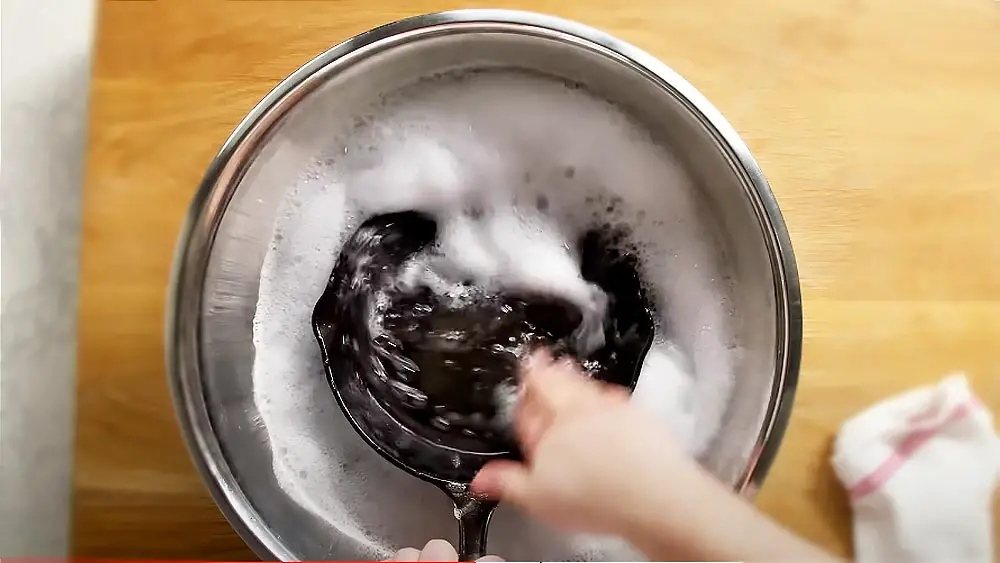
Salt Scrub
Salt Scrub is a trusted method for cleaning cast iron skillets, retaining flavor, and eliminating residues. This procedure helps those who are wary about soap and chemical cleaners for cast iron cookware. A detailed process walkthrough:
Start by scraping the skillet with a spatula or cast iron scraper to remove food and hard particles. It’s important to handle this procedure carefully to avoid ruining the skillet’s non-stick coating.
Next, generously sprinkle coarse salt like kosher or sea salt throughout the skillet while it’s heated but not hot. Salt removes food residues as a natural abrasive.
Scrub the skillet carefully with a clean, dry cloth or paper towel after equally distributing salt. Work in a circle with moderate pressure to loosen and absorb stuck-on particles. The salt’s abrasion lifts residues without damaging the skillet.
After scrubbing the skillet, rinse it with hot water. Scrub lightly while rinsing to eliminate all salt and food particles. Completely dry the skillet with a clean cloth or paper towels. Reseason it with a little layer of oil before keeping.
Boiling Water
The Boiling Water Method: This simple method uses hot water to remove residue and maintain a cast iron skillet’s seasoning. A full explanation of this cleaning process:
Scrape off any food residue or stuck-on particles from the cast iron skillet. This first phase removes bigger particles and improves cleaning efficiency. Use a spatula or cast iron scraper to avoid damaging the skillet’s seasoning.
Place the skillet on the stovetop and add enough water to cover the remains. Bring water to boil. Using hot water loosens and lifts tenacious food particles, making removal easier.
Use a stiff-bristle brush or wooden spatula to carefully scrape the skillet bottom once the water boils. The water heat loosens residues, and the brush or spatula removes them from the skillet. This mild cleaning method preserves seasoning.
Pour off the hot water and rinse the skillet again after scraping. Scrub lightly while rinsing to eliminate all loosened residues. After cleaning, dry the skillet with a clean cloth or paper towel to avoid rust. Before storing, re-season the skillet with a thin layer of oil.
Water and Vinegar Method
The Vinegar and Water Method uses vinegar’s acidity to dissolve tough residues and preserve the skillet’s flavor. An in-depth instruction on this powerful cleaning method:
Scrape off any food residue or stuck-on particles from the cast iron skillet. Removing bigger debris is essential to make cleaning more efficient. A spatula or cast iron scraper should be used to avoid damaging the skillet’s seasoning.
Mix equal parts water and white vinegar in a dish to make a solution. This vinegar solution dissolves tough food particles naturally.
Fill the skillet with vinegar and cover the remains in the sink or large container. Soak the skillet for 20–30 minutes. Acidic vinegar loosens and dissolves stuck-on particles, making them easier to remove.
After soaking, gently scrape residues using a scrub brush or sponge. Scrubbing removes residues from the skillet while vinegar’s acidity breaks them down. Pay attention to tough locations that require extra effort.
After scrubbing the skillet, rinse it with hot water and scrub lightly to remove all vinegar and loosened food particles. After cleaning, carefully dry the skillet with a clean cloth or paper towel to avoid rust. Before storing, re-season the skillet with a thin layer of oil.
Oven Self-Cleaning Method
The self-cleaning oven method is a novel and effective approach to cleaning a cast iron pan. This approach works well for cast iron skillets with heavy carbonized residues or rust. A detailed explanation of this method:
Scrape off any food residue or stuck-on particles from the cast iron skillet. Use a spatula or cast iron scraper to remove as much material as possible without damaging the skillet’s seasoning.
Prepare your oven for its self-cleaning cycle, which normally reaches 500°F (260°C). Self-cleaning cycles must burn obstinate residues and carbonized particles with high heat.
Place the cast iron pan on the oven’s center rack, empty and flammable-free. To catch drips, lay a foil-lined baking sheet or aluminum foil on the rack below the skillet.
Let the self-cleaning cycle begin, which takes many hours. The oven’s strong heat will burn off all residues, leaving the skillet clean and ready for re-seasoning.
After self-cleaning, let the oven and skillet cool fully. This stage requires patience because the skillet can be very hot.
Open the oven and carefully remove the skillet after cooling. Ash residue may be on the skillet. Remove this residue with a brush or paper towel to reveal bare cast iron.
Reseason the skillet with a thin layer of oil before using it again. This process restores non-stick qualities and prevents corrosion. Use your skillet as usual to enjoy its improved performance.
You can choose from these practical methods to clear black residue from your cast iron pan, depending on your tastes and cookware condition.
What Happens If You Don’t Clean a Cast Iron Skillet Properly?
Neglecting to clean a cast iron skillet can have negative effects on its performance and longevity. Not cleaning a cast iron skillet properly can cause:
Food Waste Buildup
Not cleaning a cast iron skillet properly can cause food residue to build up on its cooking surface. Each time you cook, oils, fats, and food particles can coat the skillet. Over time, this accumulation might form a hard-to-remove coating. This residue inhibits skillet performance and transfers unpleasant flavors to foods.
Rust Formation
Cast iron rusts after prolonged moisture exposure. Poor cleaning can leave water droplets or food residues that retain moisture on the iron. This trapped moisture causes corrosion, creating ugly and even dangerous rust spots. Rust can weaken the skillet if ignored.
Loss of Seasoning
A well-seasoned cast iron skillet has a natural non-stick surface, making it versatile and trustworthy. However, powerful detergents or scrubbers might remove the seasoning layer. This reduces the skillet’s non-stick characteristics and makes the iron more susceptible to corrosion.
Flavor Transfer
Uncleaned cast iron skillets can retain cooking residue. These leftovers may impart undesirable flavors to future dishes. When making delicate or sweet foods, leftover flavors from previous meals can be difficult.
Bacteria Grow
Lack of cleaning may not eradicate hazardous bacteria and pathogens on the skillet. Not addressing this can cause major health hazards. Cross-contamination is a hazard when the pan is used for meat and non-meat dishes.
Cleaning and caring for your cast iron skillet is essential to its longevity. Your cast iron skillet will last longer if you clean it after each use with hot water and a soft brush or sponge, dry it, and lightly season it with oil.
Can You Use Soap to Clean a Cast Iron Skillet? Why or Why Not?
Cleaning a cast iron pan with soap is doable, but it requires caution. Soap breaks down grease, oils, and food residues, which can help clean difficult or badly soiled cookware. However, moderation matters.
Use a little mild dish soap to avoid damaging the skillet’s seasoning or iron surface. Avoid abrasive scrubbers when washing the skillet with soap by using a soft sponge or brush. To remove any soap residues, rinse with hot water after cleaning. Soap leftovers might flavor future dishes.
After a soap-based cleaning, dry the skillet well to prevent rust and re-season it with a small layer of oil to restore its non-stick characteristics and protective covering. In conclusion, soap can clean a cast iron skillet, but it’s important to follow proper post-cleaning methods to retain its seasoning and performance.
How to Prevent Cast Iron Skillet Rust: A Complete Guide
Cast iron skillet rust prevention is simple: clean, season, and maintain. This comprehensive guide will help you keep your cast iron skillet rust-free for years.
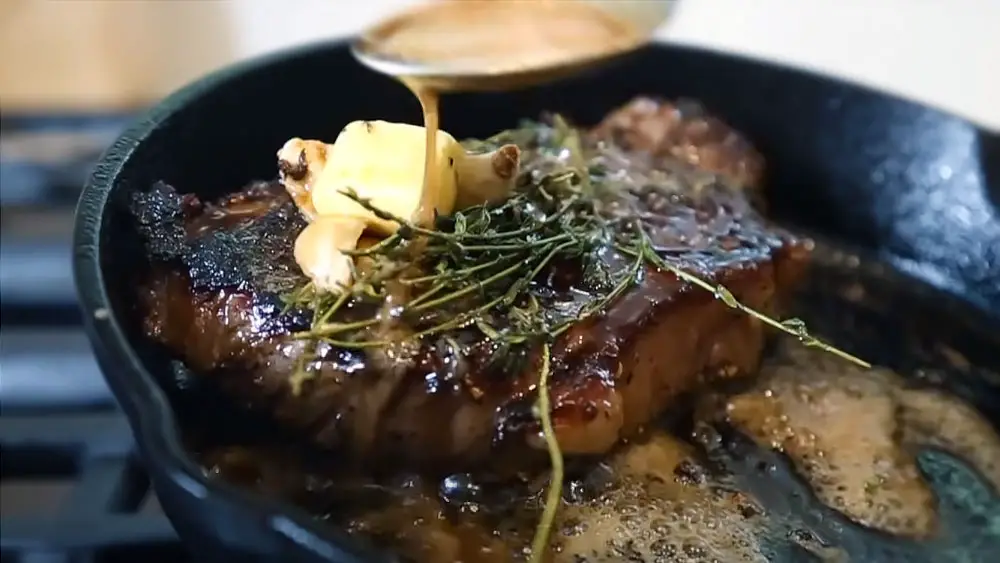
Cast Iron Skillet Seasoning
Seasoning is key to cast iron skillet upkeep. Clean your skillet with a firm brush or sponge to remove food and debris. To remove all moisture, dry the skillet. Next, coat the skillet, handle, and inside with a thin layer of cooking oil. Place the skillet upside down in a preheated 375°F (190°C) oven with aluminum foil on the rack to catch drips. An hour in the oven bonds the oil to the skillet, protecting it. Repeat this method several times, especially for new or neglected skillets, to establish a strong seasoning coating.
Good Cleaning and Maintenance
Rust prevention requires a clean, dry skillet. A little mild soap is fine, but avoid soap to keep the seasoning. Remove food residue carefully with hot water and a non-abrasive brush or scraper. After cleaning, dry the skillet with a clean towel or heat it on low to evaporate moisture. Re-season if the seasoning is thin or inconsistent. Proper storage is also important; avoid stacking cookware and store your cast iron pan dry.
Cook and Store Food Well
Your skillet’s rust susceptibility depends on cooking and storage. Avoid cooking extremely acidic meals for lengthy durations, as they destroy seasoning. Lids prevent liquid buildup when cooking. Dry components are best for the skillet because wet ones can ruin the flavor. To avoid moisture and rust, transfer food from your skillet to another container after it cools.
Check Your Skillet Regularly
Early rust detection requires frequent inspections. Check visually and tactilely regularly. Look for rust, especially where the seasoning is weak. Don’t worry about rust—you can remove it and reseason your skillet. Addressing rust quickly prevents more damage.
Remove Rust
If rust appears, fix it immediately. Scrub the rust in circles with a fine-grade steel wool pad or wire brush. Run hot water over the skillet and dry it with a clean towel. Restore your skillet’s protective covering by seasoning it as in Step 1.
Storing Cast Iron Skillets
Your skillet needs proper storage while not in use. Avoid stacking cookware in your cast iron pan to prevent moisture buildup. Add a paper towel or clean cloth to the skillet to absorb moisture. To avoid moisture buildup, store your skillet in a well-ventilated area. Use a lid or cast iron skillet cover to keep dust and moisture out.
In conclusion, by following these procedures, you can keep your cast iron skillet rust-free and a trusted cooking buddy for years.
FAQs
Can soap clean cast iron skillets?
You can clean a cast iron skillet with soap, but use caution. Traditional wisdom advises against soap to maintain skillet seasoning. Use mild dish soap only as necessary. Rinse, dry, and re-season the skillet after soaping to retain its non-stick surface.
Cast iron skillets in the dishwasher?
Dishwasher-safe cast iron skillets are not recommended. Dishwashers expose cast iron to strong detergents, high water temperatures, and moisture, which can rust and damage seasoning. Cast iron cookware should be hand-washed gently.
Can metal utensils be used in cast iron skillets?
You can use metal utensils in a cast iron skillet, but be careful. Cast iron can handle metal utensils, but excessive scraping or metal-on-metal contact can harm the skillet’s seasoning. Use wooden or silicone utensils to preserve your skillet’s seasoning.
Can you clean rusty cast iron skillets?
A rusty cast iron skillet can be cleaned and reused. Scrub the rust with steel wool or a hard brush. Then, re-season the skillet by coating it with oil or shortening and baking it. This removes rust and restores seasoning.
Can olive oil season cast iron skillets?
Olive oil can season a cast iron pan, but it’s not ideal. Olive oil has a lower smoke point than vegetable or flaxseed oils, making it less durable. For seasoning, use oils with higher smoke points to create a tougher, more robust non-stick surface.
Is cast iron skillet cooking acidic foods safe?
Acidic dishes can be cooked in cast iron skillets safely. Durable cast iron can tolerate acidic elements like tomatoes and vinegar. Long-term acidic food exposure may slightly degrade the seasoning. Season your pan and clean it after cooking acidic foods to avoid problems.
Should you reseason a cast iron skillet every time you use it?
No, you don’t need to re-season a cast iron skillet every use. Re-seasoning the skillet frequently keeps it non-stick and prevents corrosion. After each use, clean and store the skillet as directed. If you observe rust or impaired seasoning, re-seasoning may be needed.
Can a new cast iron pan fry eggs without seasoning?
A new cast iron pan can cook eggs without seasoning, however, a minor seasoning is recommended. This prevents sticking and streamlines cooking. You can season your new skillet according to the care and maintenance instructions or heat it in the oven for an hour before cooking.
Can a glass stovetop use a cast-iron skillet?
A cast iron pan can be used on a glass stovetop with few precautions. To avoid scratches, do not drag the skillet. Dropping the hefty skillet might fracture the glass. On a glass burner, use low to medium heat with your cast iron pan to avoid overheating.
Is it okay to cook fish in a cast iron pan after cooking other foods?
Even after cooking other items in a cast iron pan, fish can be cooked safely. Cast iron skillets can cook a variety of dishes because they uniformly distribute heat. To avoid lingering flavors or aromas from prior dishes impacting your fish, clean the skillet between uses.
Final Words
Maintaining a cast iron pan free of black residue is simple yet necessary for any home chef. Following this guide’s cleaning instructions will keep your skillet a trusted cooking partner. Maintaining the skillet’s seasoning while eliminating residue is vital, whether you use standard, alternative, or preventive approaches. With appropriate care, your cast iron skillet will cook well and become a family heirloom. Happy cooking!


